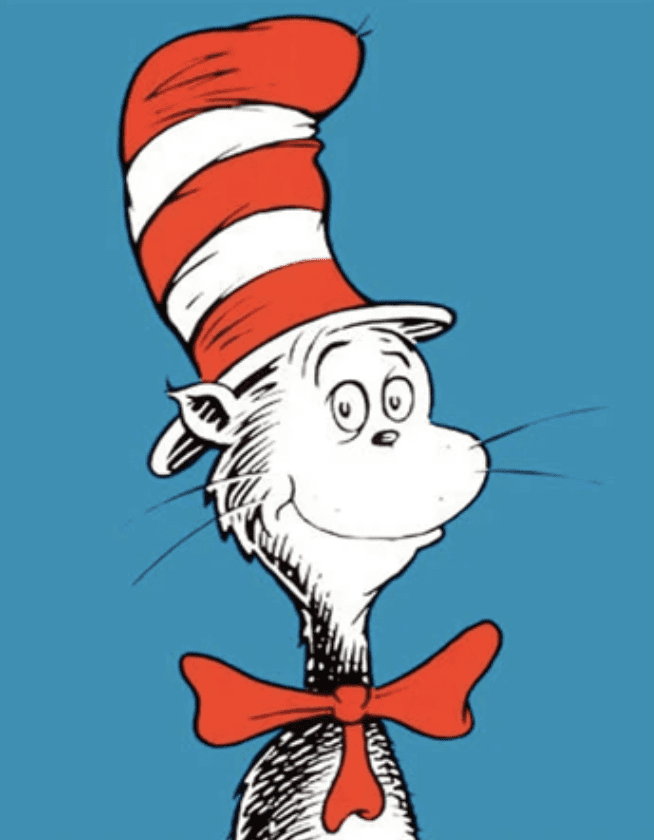The sun did not shine.
It was too wet to play.
So we sat in the house
All that cold, cold, wet day.
Do you recognize these memorable lines? It’s the opening paragraph of the classic children’s story The Cat in the Hat, written by Theodor “Dr. Seuss” Geisel in 1957.
We see Sally and her brother (who’s never named) looking sullen at the bay window of their home. It’s raining, and they can do nothing but “Sit! Sit! Sit! Sit! And we did not like it. Not one little bit.” Before long, something went “BUMP!” that made them jump. What could have made that sound? “Then we saw him step on the mat!,” they said. “We looked! And we saw him! The Cat in the Hat!”
The large anthropomorphic cat with a red-and-white striped hat (and red bowtie) has an array of tricks and games he likes to play. Sally and her brother, along with their pet fish and Thing One and Thing Two, get into many adventures and misadventures with their new feline friend before their mother gets home.
The Cat in the Hat can be best described as a rollercoaster ride of humour, whimsy, fun and merriment. Like most Dr. Seuss books, of course!
Why do I bring this up? I was recently thinking about when my wife and I read this story, and other classic Seussian tales, to our son. Andrew loved the zaniness and strange word combinations, and always liked looking at the pictures. He even got a kick out of the 1971 animated TV special featuring The Cat in the Hat, which was rather different from the book we read over and over again.
Yet, it’s fair to say he preferred (and still prefers) the modern adaptation of the titular character of Dr. Seuss’s empire. In particular, The Cat in the Hat Knows a Lot About That!, an award-winning children’s TV series which ran for three seasons on Treehouse TV, Kids’ CBC and PBS Kids between 2010 to 2018. The popular comedian Martin Short voiced The Cat in the Hat. He went on magical adventures with his two young friends, neighbours Nick and Sally, on the strange contraption known as the “Thinga-ma-jigger.” Fish, Thing One and Thing Two would make occasional appearances, too.
The Cat in the Hat Knows a Lot About That! was heavily focused on combining learning, singing and fun for preschoolers. Episodes examined how bees make honey, fireflies communicate with their lights, the principles of gravity, recycling old paper into new, balls being made with different materials, discovering that not all birds can fly, learning about single-celled creatures like an amoeba, fish that live in the sea, animals that live in the jungle – and more. There were also specials about Christmas and Halloween, as well as a trip into space.
These adventures were based on Random House’s Beginner Books, which included Dr. Seuss’s original stories like The Cat in the Hat. The other stories were part of a post-Dr. Seuss book series that my son also enjoyed, The Cat in the Hat’s Learning Library.
The latter franchise began in 1998, just seven years after Geisel passed away. Children’s authors like Tish Rabe and Kate Klimo (under the pen name “Bonnie Worth”) have written several volumes apiece, with illustrations from Aristides Ruiz, Joe Mathieu and others. Experts from different disciplines and fields of study were brought in and acknowledged for their contributions.
This was also the case for Barbara Kiefer, the Charlotte S. Huck Professor of Children’s Literature at Ohio State University. “There is a big gap between ‘concept’ books written for preschoolers and nonfiction that requires fluent reading skills,” her note reads on each book’s back cover. “The Cat in the Hat’s Learning Library books introduce beginning readers to important basic concepts about the world we live in. They provide the critical foundations upon which complex facts and ideas can eventually be built. In addition, The Cat in the Hat’s Learning Library shows young readers that books can be entertaining and educational at the same time. This is a wonderful series!” (Kiefer passed away in 2023.)
The first title released in the Learning Library was Rabe’s Fine Feathered Friends: All About Birds(1998). We don’t own that one, but we have a small number of them. Two were written by Rabe, There’s No Place Like Space! (1999, revised in 2009) and Miles and Miles of Reptiles (2009), and two by Worth, A Whale of a Tale! (2006) and One Cent, Two Cents, Old Cent, New Cent (2008).
The last title, in particular, may very well be the most creative book to help teach budding minds about money.
The Cat in the Hat, with his young friends Sally and Conrad Walden as well as Thing One and Thing Two, each paid a penny to visit the Museum of Money. They discovered that people bartered using honey, seashells, feathers and eggs. They learned about the development of metal coins in Lydia, China and ancient Greece. They saw small coins and big coins, and the advent of paper money. In the most amusing passage, they learned that on the old U.S. ten thousand dollar bill, “you will find the face of Abe Lincoln’s treasurer, Salmon Portland Chase!” What other children’s book would reference the man who served as Lincoln’s Treasury Secretary from 1861-1864? I can’t even think of one!
It’s been a fun little trip down memory lane. If my mother was still alive, I wonder if I would tell her about this – or, like Sally and her nameless brother, not know what to say.
Michael Taube, a longtime newspaper columnist and political commentator, was a speechwriter for former Canadian prime minister Stephen Harper.









